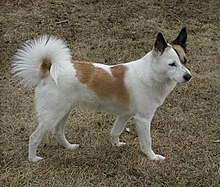Norrbottenspets
| Norrbottenspets | |||||||||||||||||||||||
|---|---|---|---|---|---|---|---|---|---|---|---|---|---|---|---|---|---|---|---|---|---|---|---|
 | |||||||||||||||||||||||
| Other names | Nordic Spitz Norrbottenspitz Pohjanpystykorva | ||||||||||||||||||||||
| Origin | Sweden | ||||||||||||||||||||||
| |||||||||||||||||||||||
| |||||||||||||||||||||||
| Dog (domestic dog) | |||||||||||||||||||||||
The Norrbottenspets, also known as the Norrbottenspitz, the Nordic Spitz and the Pohjanpystykorva, is a breed of spitz type dog from Sweden. A small to medium sized breed with typical spitz-like features, the Norrbottenspets has traditionally been kept as a hunting dog in Northern Sweden and is closely related to similar Nordic spitz breeds such as the Finnish Spitz.
History[]
The Norrbottenspets takes its name from the region of Norrbotten, in the north-east of Sweden, with "spets" being the Swedish spelling of "spitz", the breed is also known as the Norrbottenspitz, the Nordic Spitz and the Pohjanpystykorva.[1][2] The origins of the breed are unknown, it is likely both arctic and German spitz blood is present in its ancestry.[3] The Norrbottenspets is the Swedish equivalent of the closely related Finnish Spitz, the Russian Karelo-Finnish Laika and the Norwegian Buhund; the various breeds only becoming distinct with separate kennel club recognition for dogs found across various national borders.[1] Almost lost in the 20th century, in 1948 the Swedish Kennel Club declared the Norrbottenspets extinct and it was not until the 1960s that sufficient numbers were found for the breed to be declared extant.[1][3] Never having received the international attention of the Finnish Spitz or the Norwegian Buhund, the Norrbottenspets is rarely seen outside of Scandinavia, although with a revival in interest in national breeds today the Norrbottenspets is a relatively popular breed in Sweden.[1][2][3]
Description[]


The Norrbottenspets is a small to medium sized, compact and robust breed with typical spitz features.[4] Slightly smaller than the Finnish Spitz, the breed standard states dogs should stand between 43 and 47 centimetres (17 and 19 in) with bitches being slightly smaller, standing between 40 and 44 centimetres (16 and 17 in); they typically weigh between 11 and 15 kilograms (24 and 33 lb).[1][2][5] The breed has a thick, dense double coat that protects the breed well during arctic winters; the outer coat is hard, short and straight whilst the undercoat is fine and dense.[4] The breed can be seen in all colours, although white with red, yellow, cream, tan or black markings is most common; the breed standard states they should be white with either yellow or red patches.[1][4][5] The breed has a wedge-shaped head with erect ears; their body is strong and it is as long as it is tall with a deep chest.[4] Their tail is long and it is carried high, curled over their back, this typical of spitz dogs.[4]
The Norrbottenspets is described as a highly intelligent and energetic breed, they have a curious nature and require considerable exercise, becoming destructive without it.[4] Generally even tempered, the breed is said to have a low tolerance for children bothering them.[2]
Uses[]
Today the majority of Norrbottenspets are kept as pets, but traditionally the breed has been maintained as a hunting dog and general farm dog.[3][4] The breed is used to hunt a wide variety of game including gamebirds, deer including elk as well as occasionally bear, there are a many stories of Norrbottenspets chasing away bears that have attacked their master.[3][4] A tireless, determined hunter with a keen nose, many Norrbottenspets have been trained as search and rescue dogs.[3][4]
See also[]
- Dogs portal
- List of dog breeds
References[]
- ^ a b c d e f Jones, Arthur F.; Hamilton, Ferelith (1971). The world encyclopedia of dogs. New York: Galahad Books. pp. 599–602. ISBN 0-88365-302-8.
- ^ a b c d O'Meara, Sean (2008). The complete illustrated encyclopedia of dogs. New York: Metro Books. p. 155. ISBN 978-1-4351-0539-3.
- ^ a b c d e f Alderton, David (1987). The dog: the most complete, illustrated, practical guide to dogs and their world. London: New Burlington Books. p. 82. ISBN 0-948872-13-6.
- ^ a b c d e f g h i Palika, Liz (2007). The Howell book of dogs: the definitive reference to 300 breeds and varieties. Hoboken, N.J.: Wiley Publishing Inc. p. 303. ISBN 978-0-470-00921-5.
- ^ a b "FCI-Standard N° 276: Norrbottenspets" (PDF). Fédération Cynologique Internationale. 21 October 2009. Retrieved 19 January 2021.
- FCI breeds
- Spitz breeds
- Dog breeds originating in Sweden